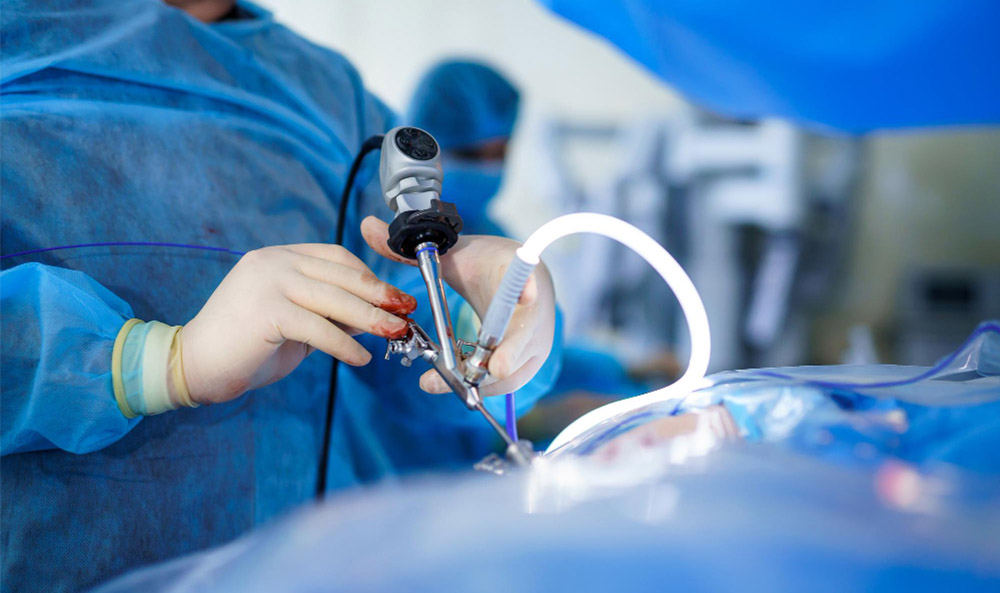Gastric Bypass
What is Gastric Bypass (Stomach Reduction)?
Gastric bypass, also known as gastric bypass, is one of the oldest surgical methods used in obesity. The main event of gastric bypass treatment is to reduce stomach volume and reduce nutrient absorption.
Gastric Bypass surgery is one of the oldest and most common operations performed in bariatric surgery in the world. This surgery is basically two-stage, first the stomach volume is reduced and the shrinking stomach is tied 50-70 cm ahead of the small intestine. In other words, the foods continue by bypassing (bypassing) a large part of the intestine after the stomach. In this way, nutrients are both volume-restricted and less absorbed.

How is Gastric Bypass Applied?
Gastric bypass is a surgical procedure performed laparoscopically under general anesthesia. Because it is closed, small incisions are made in the abdomen, not large incisions. Gastric bypass basically takes place in two steps. Our first step is stomach reduction, and the second step is bypass.
For the first step of the Gastric Bypass operation, that is, for stomach reduction, 4-5 entrances to the abdomen are opened to reach the stomach and surrounding tissues. The process done here is to divide the stomach into two parts, the large part that is divided is disabled, and the small part in the size of a walnut is where the food will go. The important point here is that the stomach is not removed from the body.
In the second step, it is the process of connecting the stomach to the intestine, which we divide into two and take the small part of it. The stomach, which we have reduced in volume here, is connected to the second part by bypassing the large first part of the small intestine. Thus, first the amount of food taken into the body decreases as the stomach shrinks and a feeling of early satiety occurs, and then calorie absorption is reduced as most of the intestine is skipped.

Gastrik Bypass Nasıl Uygulanır?
Gastrik bypass genel anestesi altında laparoskopik yöntemle yapılan cerrahi bir işlemdir. Kapalı olması sebebiyle karın bölgesine geniş kesiler değil küçük girişler açılır. Gastrik bypass temelde iki adımda gerçekleşir. Birinci adımımız mide küçültme, ikinci adımsa bypass işlemidir.
Gastrik Bypass operasyonunun birinci adımı yani mide küçültme için, karın bölgesine 4-5 giriş açılarak mideye ve çevre dokulara ulaşılır. Burada yapılan işlem mideyi iki parçaya bölmektir, bölünen büyük kısım devre dışı bırakılır ceviz büyüklüğündeki küçük kısım ise gıdaların gideceği yerdir. Burada önemli nokta midenin vücuttan çıkarılmamasıdır.
İkinci adımda ise ikiye bölerek küçük kısmını aldığımız midenin bağırsağa bağlanması işlemidir. Burada hacimce küçülttüğümüz mide, ince bağırsağın büyük ilk kısmını atlayarak (bypass) ikinci kısma bağlanır. Böylelikle önce mide küçüldüğü için vücuda alınan besin miktarı azalır ve erken tokluk hissi oluşur, daha sonra da bağrsağın büyük bölümü atlandığı için kalori emilimi azalmış olur.
Who is Suitable for Gastric Bypass Surgery?
People who want to have Gastric Bypass surgery must meet certain criteria. The main criteria for gastric bypass are;
- To be between the ages of 18-65 for surgery. In some special cases, this surgery can also be performed in people under the age of 18 and over the age of 65.
- Morbid (fatal obesity) obese patients with a body mass index above 35-40 are the first candidates for gastric bypass operation.
- Gastric bypass is also preferred for weight-related co-morbidities such as type 2 diabetes, high blood pressure, and high cholesterol.
- As a result of detailed examinations by specialist physicians, everyone can have gastric bypass surgery, as long as there is no disease that will risk the surgery and the patient can handle anesthesia.
Who Is Not Suitable For Gastric Bypass Surgery?
All surgical operations are performed under certain criteria. Before each procedure, extensive examinations are made to clarify whether the patient is suitable or not.
- First of all, the patient should not have an obstacle to anesthesia, an ongoing treatment, substance and alcohol addiction.
- After the surgery, it will be necessary to make radical changes in nutrition and lifestyle. For this reason, the patient should be at a level that can accept this change.
- Since obesity brings with it diseases such as endocrine system disorders, metabolic surgical procedures are also used in the treatment of these diseases. Therefore, there is no general obstacle to gastric bypass surgery for diabetes patients. However, the final decision to eliminate unexpected situations is again made by the physician.
Before Gastric Bypass Surgery
Before the Gastric Bypass surgery, the patient’s condition is evaluated by performing routine examinations. For healthy results, the patient should be fasting for at least 10 hours and without water for 8 hours before these tests.
Since it is a serious operation, the results of the examination are evaluated by working in coordination with many departments. The examinations made;
- Blood Tests
- Abdominal Ultrasound
- Hormone Tests
- ECG
- Anesthesiology
- Cardiology
- Chest diseases are checked.
If there is no problem, the patient’s operation plan is started to be prepared. Before each surgical procedure, the necessary preliminary information is given to the patients by the doctor. The patient’s compliance with these is very important for the success of the surgery.
Before gastric bypass surgery;
- It is recommended to follow a diet for 1 week or 10 days to reduce the fat in the liver.
- All drugs without the doctor's permission should be discontinued.
- Since alcohol and smoking shorten the healing process, it may be necessary to quit at least 1 week in advance.
- If blood thinners such as allergy medications are used, the doctor should be informed.
For a successful surgery, everything should be shared with the physician and possible risks should be minimized.


After Gastric Bypass Surgery
Postoperative hospital stay is approximately 4-6 days. The patient stays in the intensive care unit for 1-2 days. After the 3rd day, watery foods are started to be consumed and in the following period, soft foods such as puree are continued. Painkillers are given intravenously so that the patient does not feel pain.
Since the mechanical structure of the stomach changes after Gastric Bypass surgery, the patient needs to make changes in his nutritional routine. The most important element of the post-operative recovery process is the diet, people who have this surgery should remove acidic and carbonated drinks from their lives. In order not to tire the stomach too much, foods that are difficult to digest should be avoided. Since the stomach volume is reduced, the patient will experience a feeling of fullness with less food, so it is more appropriate for the foods taken to be fat-free. In addition, liquids that will cause bloating should not be consumed quickly.
Special programs are given to each patient by specialist dietitians and physicians. If these diet and sports programs are followed, patients can reach their ideal weight within an average of 1 year.
Advantages of Gastric Bypass Surgery
- It has a high permanence and effect as it reduces both stomach reduction and absorption.
- It also treats obesity-related co-morbidities such as type 2 diabetes.
- Since the stomach is not removed, it is possible to return it to its original state.
- Cases in which patients experience distress after surgery are rare.
- Compared to sleeve gastrectomy surgery, the situation of regaining weight is very low.
- A large proportion of 75% of excess weight is lost within 1 year after surgery. This weight loss reaches 80-90% in the second year. While reaching the ideal weight, an improvement is observed in the diseases accompanying obesity.
Gastrik Bypass Ameliyatı Dezavantajları
- Gastric bypass surgery is a long and complex procedure. This type of obesity operations have some risks in the future. These risks are also higher in gastric bypass surgery than in sleeve gastrectomy surgery. Since this operation causes malabsorption, periodic checks should be made and the missing vitamins and minerals should be supplemented.
- Since the first part of the small intestine, where iron and calcium absorption is high, is disabled, a tendency to iron deficiency anemia may occur in the body.
- "Dumping syndrome" can be seen after gastric bypass surgery. This syndrome means rapid emptying of stomach contents into the small intestine. Although it is not seen as a serious risk for health, it can be extremely disturbing, sometimes seen as nausea, weakness, sweating, fainting, etc. after a meal.
Images from Operations







